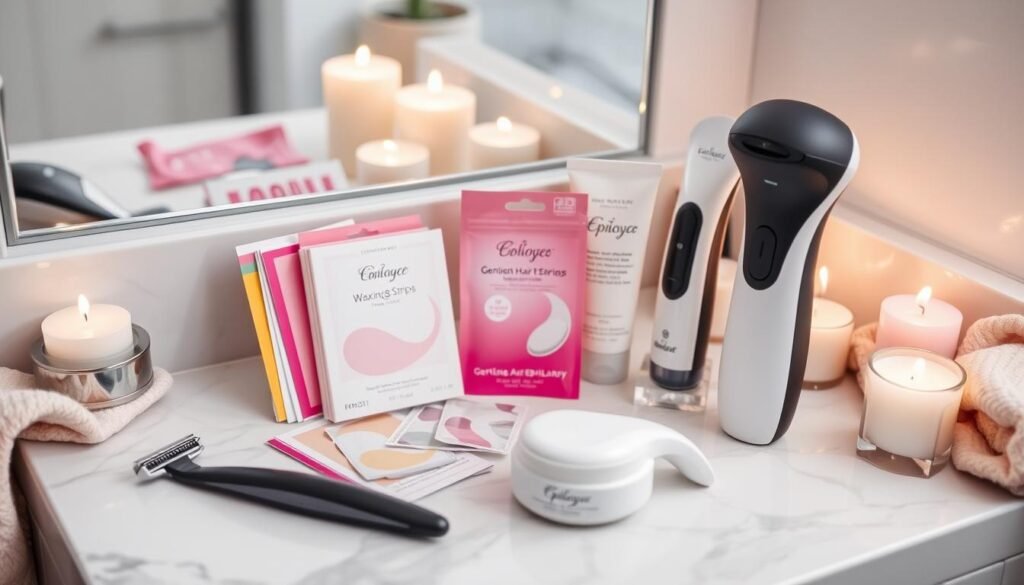Did you know hirsutism impacts 5% to 15% of women? Over 70% of these cases are due to polycystic ovary syndrome (PCOS). This fact reveals a common problem and shows the emotional struggles from excess hair growth. Women with PCOS and hirsutism often face anxiety and low self-esteem. Thus, finding good hair removal methods for PCOS hirsutism is essential.
Thankfully, there are many hair removal options available, each with benefits and challenges. These range from medications to laser treatments. Picking the right method is key. It tends to involve a mix of techniques to meet personal needs. Knowing these options helps women with PCOS ease the burden of unwanted hair.
Key Takeaways
- Hirsutism affects 5% to 15% of women, primarily due to PCOS.
- Effective hair removal options include laser treatments, electrolysis, and hormonal medications.
- On average, it takes about six months to notice improvement with medical treatments.
- Combination therapy can be particularly effective in managing hair growth.
- Temporary methods like shaving and waxing provide quick relief but require regular maintenance.
Understanding Hirsutism in Women
Hirsutism affects many women by causing excess hair growth in places like the face and chest. About 4–11% of women in the general population have hirsutism. Yet, this number jumps to 65–75% for women with polycystic ovary syndrome (PCOS). This shows how hirsutism is linked to women’s hormonal health issues.
Hair growth varies by ethnicity. For instance, Mediterranean people may have more hair than Asian and American Indian folks. It’s important to know these differences to recognize hirsutism’s variation.
Hirsutism’s mental impact is huge. Women dealing with it may feel anxious or depressed because of beauty norms. Understanding its psychological effect is crucial. Early action can lessen its effects and boost women’s health and happiness.
What Causes Hirsutism in PCOS?
Hirsutism means too much hair grows on women’s bodies. It often comes from hormonal imbalances. A main reason for it is polycystic ovary syndrome (PCOS). This affects about 70% of women with PCOS. PCOS starts at puberty and can cause missed periods, weight gain, and trouble having babies.
High levels of male hormones, or androgens, make this problem worse. They change soft hair into thick, dark hair in places like the face. Family history can affect this too. Some health problems that you can inherit make it more likely. Women from the Mediterranean, Middle East, and South Asia might get this condition more often, but we don’t always know why.
Being overweight can make hirsutism more severe by raising androgen levels. These hormonal imbalances can also hurt your emotional well-being. They often lead to feelings of sadness or worry because of the hair growth.
Knowing why hirsutism happens helps doctors find out if you have it. It also shows why getting medical help is so important. Doctors might use blood tests, ultrasound, or hormone tests to figure out the best treatment. They can then help manage the unwanted hair and its root causes.
Symptoms and Diagnosis of Hirsutism
Hirsutism can change how women look and feel. It often causes unwanted hair on the face, chest, and back. Some women may also have irregular periods and skin issues like acne.
To diagnose hirsutism, doctors start with a detailed look at medical and symptom history. They use blood tests to check androgen levels. High androgens can point to conditions like PCOS or adrenal tumors.
If you have these signs, getting medical help early is crucial. Finding the cause early means better treatment options. This not only tackles hair problems but also boosts overall health.
Excess Hair Growth: The Role of Androgens
Excess hair growth, known as hirsutism, is a common issue. It can affect up to 10% of women worldwide. This condition is usually tied to hormonal imbalances, especially too much androgen. Androgens are male hormones that women also have in smaller amounts. In hirsutism, 60 to 80 percent of women show more androgens in their systems. This leads to coarse hair on their faces, chests, and backs.
Androgens play a big part in hirsutism. They interact with hair follicles that are too sensitive. For many women, too much androgen and sensitive hair follicles mean too much hair. The main hormone issue behind hirsutism is Polycystic Ovary Syndrome (PCOS). It’s linked to about 75% of all hirsutism cases. Around 70% of women with PCOS have too much androgen.
There are other things that can make hirsutism worse. Family traits, problems with adrenal glands, and even outside androgen sources play a role. About 10% of hirsutism cases are called idiopathic. This means they might be due to family history.
It’s key to understand why hirsutism happens, especially the part androgens play. To manage it, doctors often check hormone levels with tests. This helps them see which hormone is out of balance. As we learn more about its mental effects, treating hirsutism becomes even more important. It’s all about making life better for women who are dealing with it.
| Factor | Impact on Hirsutism |
|---|---|
| Androgen Levels | Increased levels lead to excess hair growth |
| Polycystic Ovary Syndrome (PCOS) | Accounts for 75% of hirsutism cases |
| Familial History | Common in those with idiopathic hirsutism |
| Adrenal Disorders | Can contribute to hyperandrogenism |
| Exogenous Androgens | External sources can exacerbate symptoms |
Hair Removal Options for PCOS-Related Hirsutism
Handling PCOS-related hirsutism is tough, making many look for good hair removal methods. There are many ways to remove hair, giving people choices that fit their needs and preferences.
Laser Hair Removal
Laser hair removal is a great long-term option for getting rid of unwanted hair. It uses focused light to hit hair roots, working well for those with dark hair on light skin. Though effective, you might need several treatments for the best results. It’s not perfect for every skin type. For those interested, you can check out special services for managing PCOS.
Electrolysis
Electrolysis attacks each hair root with electric currents. It promises lasting results for any hair color. Though it takes time and effort, the outcomes are solid for small areas. People should know it’s a commitment but a worthwhile option for hair removal.
Shaving Techniques
Shaving is easy to do and gives quick results. It’s perfect for those needing a fast solution. But, it’s a short-term fix, needing frequent maintenance. It may make hair grow back rougher. So, it’s good to combine shaving with other methods for smoother skin.
Temporary Hair Removal Methods
If you want quick results in removing unwanted hair, there are temporary methods for you. Waxing and depilatories are two popular choices. Each has its own advantages and things to think about.
Waxing
Waxing is a top choice for temporary hair removal. It pulls hair out from the root, leading to smooth skin for weeks. While it lasts longer than many methods, it might irritate some people’s skin. If you wax regularly, you might notice less hair growth over time.
Depilatories
Depilatories offer a quick, pain-free way to remove hair. They work by dissolving hair just above the skin. However, they can make skin sensitive or cause reactions. Always do a patch test before using them widely on your skin. For more information on hair removal, you can check out this link.

| Method | Duration of Results | Skin Sensitivity | Cost |
|---|---|---|---|
| Waxing | 3-6 weeks | Possible irritation | Varies by location |
| Depilatories | 3-10 days | Possible sensitivity | Generally low |
Natural Remedies for Hirsutism
Many women looking for ways to manage hirsutism turn to natural remedies. Conditions like PCOS can make androgen levels rise. This leads to more hair growth. Natural treatments can help along with regular hirsutism treatments.
Spearmint tea is a great choice. Studies suggest it can lower androgen levels in those with PCOS. Drinking it often might reduce hirsutism symptoms. It’s a simple addition to your daily routine that could help control hair growth.
A study found that fennel extract affects hair growth and thickness. Women using a stronger fennel cream saw big improvements. Plus, licorice may help lower testosterone levels, aiding in hormone balance.
Herbal mixes like ginger and neem also offer hope in treating hirsutism symptoms. These natural remedies are gaining attention in women’s health research.
While there are many natural remedies, more research is needed to prove their effectiveness. Eating a balanced diet with enough zinc can help with hormone balance. Losing a little weight can also improve symptoms. For more on herbal remedies for hirsutism, check out reputable sources. Here’s a helpful article: natural solutions for hirsutism.
Medications to Manage Hirsutism
Various medicines are used to manage hirsutism. Knowing these options helps women choose the best treatment. Hormonal treatments and anti-androgens are key in reducing excessive hair growth.
Hormonal Treatments
Hormonal treatments help balance hormone levels. They are often used to lessen hirsutism symptoms. These include oral contraceptive pills that reduce androgen production, thus lessening hair growth. PCOS-affected women find these treatments very effective. About 70-80% of women with excessive hair growth have PCOS. Medicines like Metformin are also used to lower insulin levels, affecting hair growth.
Anti-Androgens
Medicines like spironolactone and cyproterone acetate benefit women with hirsutism. They block the action of male hormones that cause hair growth. These are effective in 75-85% of cases of hirsutism from androgenic causes. Spironolactone can reduce hair growth in those with too many male hormones. Users might experience side effects like irregular periods and breast tenderness. They should talk these over with their doctor.
A cream called eflornithine is another option for controlling unwanted facial hair. It slows down hair growth and is usually well-received by users. Knowing the different medicines available can lead women to the best treatment plan for their needs.

| Medication Type | Examples | Mechanism of Action | Potential Side Effects |
|---|---|---|---|
| Hormonal Treatments | Combined Oral Contraceptive Pills, Metformin | Regulates hormones, reduces androgen production | Nausea, mood changes, irregular periods |
| Anti-Androgens | Spironolactone, Cyproterone Acetate | Blocks androgen receptors, decreases hair follicle sensitivity | Menstrual irregularities, breast tenderness |
| Topical Treatments | Eflornithine Cream | Slows facial hair growth | Skin irritation, burning sensation |
The Role of Weight Management in Treating PCOS
Weight management is key in treating polycystic ovary syndrome (PCOS), impacting 5 to 10 percent of women. This condition can cause excessive hair growth and distress. Losing weight can reduce androgen levels, easing these symptoms.
Studies show obese women with PCOS are more likely to get prediabetes compared to those without PCOS. About 35 percent face impaired glucose tolerance by 40. Good weight management can lower the risk of type 2 diabetes. Up to 10 percent of obese women with PCOS may develop this disease. This underlines the need for a healthy diet and regular exercise in managing PCOS.
Hormonal treatments like estrogen-progestin contraceptives are often used first to treat excessive hair growth. If not effective, antiandrogen drugs like spironolactone may be used. Bariatric surgery could be an option for very obese patients, often helping with weight loss and PCOS symptoms.
Lifestyle changes can also boost overall health and life quality, beyond managing weight. Exercising and eating nutrient-rich foods balance insulin. This helps regulate hormones. Given the difficulty of dealing with hirsutism, weight management strategies are crucial for women with PCOS.
| Category | Details |
|---|---|
| PCOS Prevalence | 5 to 10 percent of females |
| Obesity Risk | Three-fold increased risk of prediabetes |
| Prediabetes Development | 35 percent of obese females by age 40 |
| Type 2 Diabetes Risk | Up to 10 percent of obese females with PCOS |
| Menstrual Regularity | Fewer than six to eight periods per year |
| Initial Treatment | Hormonal treatment with estrogen-progestin contraceptive |
| Secondary Treatment | Antiandrogen medication (e.g., spironolactone) |
| Weight Loss Surgery | Recommended for severely obese females |
| Benefits of Lifestyle Changes | Improved overall health, balanced insulin levels |
Long-Term Management Strategies for Hirsutism
Managing hirsutism, especially with PCOS, requires a well-rounded strategy. This includes lifestyle changes, medical treatments, and choosing the best hair removal options. Regular check-ups are crucial to measure hormone levels and treatment success.
Lifestyle changes make a big difference for those with PCOS. Losing weight can improve your health and might lessen hirsutism symptoms. Eating right and exercising can balance your hormones.
For medical treatment, options depend on what you need. Doctors often suggest birth control pills to regulate periods and lower androgens. Adding anti-androgen drugs may help even more with hair growth.
Here’s a quick list of strategies for managing hirsutism long-term:
| Strategy | Description | Notes |
|---|---|---|
| Lifestyle Modifications | Adopting a balanced diet and regular exercise. | Essential for overall well-being and hormone balance. |
| Regular Medical Follow-Ups | Routine check-ups to monitor hormone levels. | Adjust treatment plans based on needs. |
| Combination Therapy | Oral contraceptives paired with anti-androgens. | Can improve response to treatment. |
| Hair Removal Methods | Electrolysis and laser treatments for long-term results. | Choose techniques based on hair and skin type. |
| Topical Treatments | Eflornithine cream for rapid results. | May be combined with other hair removal methods. |
Using these strategies can improve life for women with PCOS and hirsutism. By tailoring care, we can help achieve lasting benefits.

Combining Hair Removal Methods for Best Results
People with hirsutism from PCOS often find better results by mixing hair removal methods. Experts suggest using both temporary and lasting solutions. This approach helps not just with looks but also in managing PCOS over time.
Effective hair removal includes laser treatments and electrolysis. Laser treatments work well, especially for those with light skin and dark hair. One session can cut hair growth by 40%. With more sessions, you can reduce hair by up to 90%. These results can last for a year, offering a good long-term option.
Electrolysis, however, gives a permanent solution to unwanted hair. It’s effective, but insurance may not cover it due to its cosmetic nature. Yet, for many with PCOS, it brings mental health benefits. It helps reduce stress and boosts how they see themselves.
Adding hormone treatments like spironolactone can also help. While not officially approved for PCOS, many healthcare workers use it with hair removal methods. This combined approach can give better results.
| Method | Effectiveness | Duration of Effects | Considerations |
|---|---|---|---|
| Laser Hair Removal | Up to 90% hair reduction | Results can last 12 months | Best for light skin and dark hair |
| Electrolysis | Permanent hair removal | Permanent | Not typically covered by insurance |
| Hormonal Treatments | Varies (can enhance other methods) | Ongoing usage required | Consultation needed for best practices |
Making a customized plan that mixes hair removal methods can improve PCOS treatment. Considering personal needs and adjusting treatments, like adding eflornithine cream during laser sessions, can lead to superior outcomes. This is especially true for women with hormonal imbalances.
Conclusion
Dealing with hirsutism, especially for women with PCOS, needs careful thought. There are many ways to remove hair, like laser, electrolysis, and hormone treatments. These choices help women with PCOS manage their symptoms better.
Research shows that drugs like spironolactone and laser treatments can really cut down on hair growth. It usually takes six to eighteen months to see results. These treatments also help women feel better about themselves.
To wrap up, beating hirsutism is all about personalized care. Talking to doctors for advice helps women find the best hair removal options. They can tackle hirsutism with confidence and a hopeful heart.